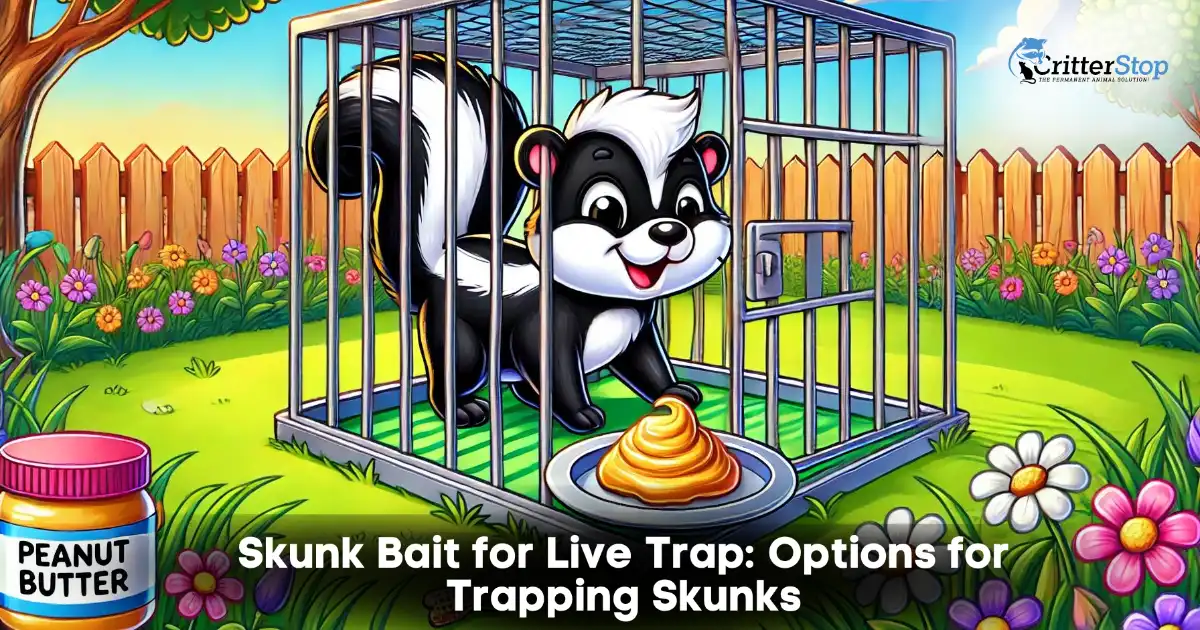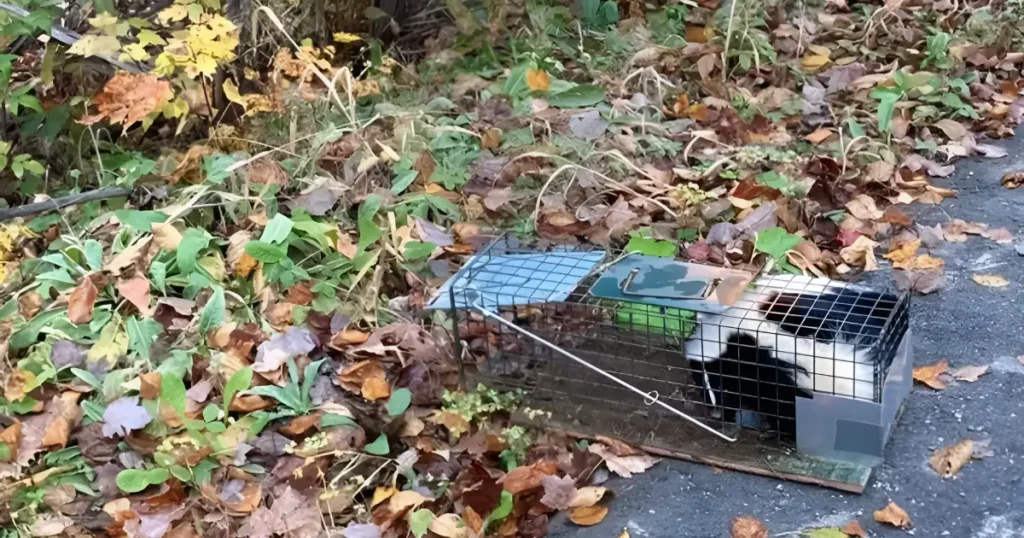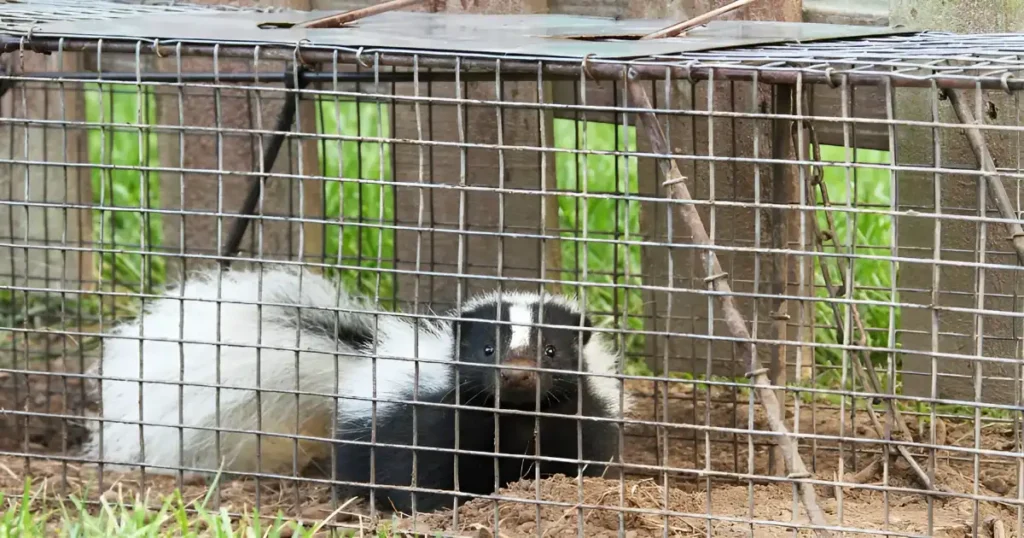
Skunks are notorious for their pungent scent and their invading residential areas can bother those living there. While trapping and relocating skunks may seem like a viable solution, it can be challenging to lure them into the trap. This is where skunk bait for live traps comes in.
Skunk bait attracts skunks into the live trap, making it easier to capture and relocate them. When trapping a skunk it’s very important to choose a good bait, and there are several options available.
Common skunk baits include canned fish, cat food, and peanut butter. These options have strong scents that are appealing to skunks and can entice them into the trap. However, it's essential to ensure that the bait is securely placed in the trap to prevent the skunk from stealing it without getting caught.
Skunks’ potent spray, which they use as a defense mechanism, and their black and white stripes are perhaps their most famous characteristics. They are found throughout North America, from Canada to Mexico, and are most commonly found in wooded areas, fields, and suburban neighborhoods. Skunks are omnivorous, which means they eat both plants and animals. Their diet typically consists of insects, small rodents, fruits, and vegetables.
Skunks are attracted to areas where they can find food and shelter. They search for insects and grubs, for which they famously dig up lawns and gardens, and will often take up residence under decks, sheds, and other structures. Some common skunk food baits include:
To attract skunks to a live trap, it's important to use a bait that they find appealing. Some common skunk baits include canned cat food, fish, and peanut butter. It's important to place the bait at the back of the trap to ensure that the skunk enters the trap fully.

When it comes to selecting the right live trap for skunks, there are a few options available. When it comes to skunks, some common live traps include cage traps, box traps, and tube traps.
Typically made of wire mesh, cage traps have a door that closes when the animal enters the trap. Box traps are similar to cage traps but are enclosed on all sides, which can help to prevent the skunk from spraying. Tube traps are long and narrow and are designed to allow the skunk to enter but not turn around, making it easier to remove the animal without getting sprayed.
When selecting a live trap, it's important to consider the size of the skunk and the size of the trap. If it is too small, a trap may not work as well, while a trap that is too large may make it difficult to handle and transport the skunk.
Once you have selected the right live trap, it's important to place it in the right location. It's best to set the trap at night and check it in the morning, as skunks are nocturnal creatures. The trap should be placed in areas such as near garbage cans or in a garden, where skunks are known to frequent.
When setting the trap, it's important to wear gloves and take precautions to avoid getting sprayed. Skunks can spray up to 10 feet, so it's important to keep a safe distance. It's also important to cover the trap with a blanket or tarp to help calm the skunk and prevent it from spraying.
When it comes to baiting the trap, there are a few options available. Skunks are attracted to a variety of foods, including peanut butter, canned cat food, and sardines. It's important to choose the right bait, as you can attract other animals and make it more difficult to catch the skunk otherwise.
By selecting the right live trap and taking the necessary precautions, it’s possible for you to catch skunks without getting sprayed. However, if you’re unsure about taking care of this process yourself, it’s always a good idea to get in touch with a professional wildlife removal company.
Skunks are omnivores and will eat almost anything, but there are certain foods that they find particularly enticing. When it comes to selecting bait for a live trap, the following options have been known to work:
If you prefer to make your own skunk bait, there are several recipes you can try. Keep in mind that these recipes may not work as well as the options listed above, but they are worth a try.
When using homemade skunk bait, it's important to remember that skunks have a strong sense of smell. To avoid leaving your scent on the bait, make sure to wear gloves when handling it.
In conclusion, if you are asking “how do you bait a skunk?”, then the answer is that, overall, the key to baiting a skunk is to use a strong-smelling, meaty food that will attract the skunk's attention. Whether you choose to use canned fish, peanut butter, marshmallows, or a homemade recipe, the right bait can make all the difference in successfully trapping a skunk. Additionally, you can hire a professional wildlife removal company, as they will know the best bait to use in your specific situation, thus ensuring that the skunk takes the bait.

Before setting up the trap, it's important to prepare the bait. Skunks are known to be attracted to a variety of foods such as peanut butter, cat food, and sardines. It's important to choose a bait that is strong-smelling and appealing to the skunk. Once the bait is prepared, it's time to move on to setting up the trap.
When setting up the trap, it's important to choose a location that is near the skunk's den or known feeding area. Skunks are creatures of habit and are more likely to be caught in a trap that is placed in their regular path.
To set up the trap, place the bait at the back of the trap and secure the trap door in the open position. It's important to ensure that the trap is stable and won't tip over when the skunk enters.
It's important to check the trap regularly once it is set up. Being left in a trap for an extended period of time can make skunks stressed and dehydrated. It's recommended to check the trap at least once a day and release any captured skunks as soon as possible.
In conclusion, setting up a live trap for skunks requires careful preparation of the bait and a secure location for the trap. These steps make it possible for you to trap a skunk while minimizing stress to it. And remember; if you are unsure about doing this yourself, you can always get in touch with a humane professional wildlife removal company.
When using skunk bait for live traps, safety should be a top priority. Skunks’ famously pungent spray can cause irritation to the eyes and skin. Therefore, it is recommended to wear gloves and protective clothing when handling the bait and setting up the trap.
Placing the trap in a safe location, away from children and pets, is also very important. It is best to avoid any unnecessary contact with skunks, as they can be aggressive when cornered.
Before using skunk bait for live traps, it is important to consider the legal and ethical aspects of trapping wildlife. In Texas, it’s legal to trap a skunk and you don’t need a license to do so, but this may not be the case in other places. Checking with local authorities is key to ensure compliance with any regulations.
You should also consider the ethical implications of trapping and relocating wildlife. Skunks are an important part of the ecosystem and play a role in controlling insect populations. It is recommended to only trap skunks if they are causing damage to property or posing a threat to human health and safety.
Overall, when using skunk bait for live traps, it is important to prioritize safety and consider the legal and ethical implications of trapping wildlife. These precautions and considerations make it possible for individuals to manage skunk populations.

After successfully capturing a skunk, it is important to handle it carefully to avoid getting sprayed. The skunk will be stressed and scared, so it approaching it slowly and calmly is key. Wear gloves and use a thick blanket or towel to cover the trap while handling the skunk.
To release the skunk from the trap, use a long stick or pole to lift the trap door from a safe distance away. Once the skunk has left the trap, avoid touching it and give it space to run away.
If you need to transport the skunk to a different location, use a sturdy and secure carrier to prevent the skunk from escaping or causing harm.
When relocating a captured skunk, it is important to release it in a suitable habitat with access to food, water, and shelter. Choose a location at least six miles away from the capture site to prevent the skunk from returning.
Before releasing the skunk, check with local wildlife authorities to ensure that it is legal to relocate skunks in your area. In Texas, you don’t need a permit to do so, but this may be the case in other places. Nevertheless, contacting a licensed wildlife rehabilitator for assistance is always a good idea to ensure that the skunk won’t return.
Remember, skunks play an important role in the ecosystem by controlling insect and rodent populations. Handling them with care and respect to ensure their safety and well-being is key.
To prevent future skunk intrusions, one key measure is to secure potential entry points. Skunks are opportunistic creatures and will take advantage of any opening they can find. Homeowners should inspect their property for any gaps or holes in the foundation, walls, or roof. Any openings should be sealed with caulk or foam insulation.
Garage doors and windows should also be checked for any gaps or cracks. To seal gaps around doors and windows, you can wheatherstrip them. A metal barrier can be installed at the bottom of the garage door to prevent skunks from burrowing underneath.
Several natural deterrents and repellents can be used to prevent skunk intrusions. A good method is to plant certain types of plants around the perimeter of the property. Skunks are repelled by the smell of certain plants such as lavender, marigolds, and mint.
Another method is to use predator urine. Skunks are afraid of predators such as coyotes and foxes. Predator urine can be purchased online or at certain outdoor stores. The urine can be sprayed around the perimeter of the property to deter skunks from entering.
Finally, homeowners can use bright lights and loud noises to deter skunks. Skunks are nocturnal creatures and prefer dark, quiet areas. By installing motion-activated lights and playing loud music or making loud noises, homeowners can make their property less attractive to skunks.
By taking these preventative measures, homeowners can reduce the likelihood of future skunk intrusions. If a skunk does enter the property, homeowners should contact a professional wildlife removal service to safely and humanely remove the animal.
If you’re dealing with a skunk invasion in your home, Critter Stop can help! We are a fully licenced and insured professional humane wildlife removal company that has earned a five-star reputation for our excellent service to commercial and residential customers in Texas. Contact Us at (214) 234-2616 to book your free inspection and estimate today!

Skunks are attracted to a variety of food items, but some homemade bait options that work best well for capturing skunks in a live trap are mixtures such as peanut butter with canned fish. This combination has a strong odor that is irresistible to skunks. Other homemade baits that have been known to work well include marshmallows, sardines, and cat food.
Marshmallows work well as a bait for trapping skunks, but they may not be as effective as other types of bait. Skunks are primarily attracted to strong odors, and marshmallows do not have a very strong scent. However, if no other bait is available, marshmallows can be used as a last resort.
Skunks are attracted to a variety of food items, but the most irresistible types of food include canned fish, peanut butter, sardines, cat food, and chicken. These foods have a strong odor that is highly attractive to skunks.
To safely remove a skunk from a live trap without provoking it to spray, it is important to approach the trap slowly and quietly. Use a thick blanket or tarp to cover the trap, and then slowly lift the trap and move it to a safe location for release. To not startle the skunk, avoid making sudden movements or loud noises .
There is always a risk of skunks spraying when they are confined in a live trap, but this risk can be mitigated by taking certain precautions. First, make sure that the trap is well-ventilated to reduce the skunk's stress level. Second, cover the trap with a thick blanket or tarp to reduce the skunk's visibility and anxiety. Finally, approach the trap slowly and quietly to avoid startling the skunk.
Visit our Critter Library and learn more about our furry friends